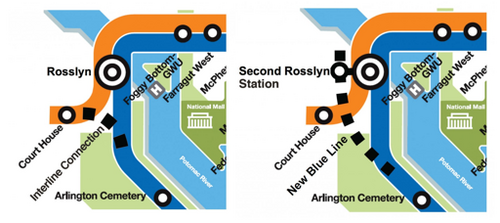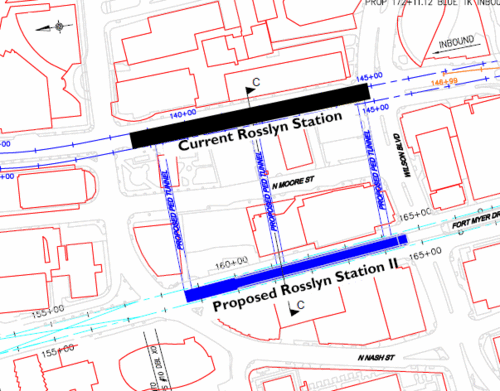A “wye” is out, but a second Rosslyn station may make more Blue Line trains possible
Metro’s planners have been studying ways to deal with the capacity crunch at Rosslyn station. A track connection from Court House to Arlington Cemetery isn’t possible, but a second station for the Blue Line is, and could be built by 2025.
Each Metro track segment is limited to 26 trains per hour (TPH). At Rosslyn, where the Blue, Orange, and (soon!) Silver Lines come together, this limits the number of trains on each line. In 2012, Metro reduced the number of Blue Line trains to allow more Orange Line capacity. Later this month, the number of Blue Line trains will decline even more to make room for the Silver Line.
There’s really no way to alleviate this crunch without additional track capacity. Eventually, it’s likely that a second subway across downtown will be necessary to handle the ridership. Metro is currently exploring the idea of building a new loop line through the central city. A new subway would allow Orange and Silver lines to each have 13 slots, and the Blue Line could also to have increased service up to 13 TPH.
Earlier, Metro was looking at two ways to address the capacity constraints. One concept was a “wye” track connection, to allow trains coming from Court House to turn south and go toward Arlington Cemetery and vice versa. The follow-up study this year, though, determined that building foundations make this option impossible.
The other option, though, is feasible. It would require building a second station one block west of the current Rosslyn station. This new platform would connect to the existing Rosslyn station with a pedestrian tunnel. At least initially, only the Blue Line would use it. The Orange and Silver lines would stay in the current station.
If built, this would mean that the Blue Line would only operate between Franconia-Springfield and Rosslyn (though some Yellow Line trains might still start and end in Franconia as they do today). That would mean that, at least until the line is extended across the Potomac, Blue Line riders would need to transfer to an Orange or Silver line train at Rosslyn to get downtown. But all the lines at Rosslyn would be coming more frequently than they do today, which might alleviate the inconvenience of changing trains.
These diagrams I made last year show how the new station (and the infeasible wye) could work.
The wye would have allowed for more trains on the new Silver Line tracks and given riders from Alexandria and south Arlington a one-seat ride to Court House, Clarendon, etc. (if they caught the train every ten minutes going that way), but it also would have made service more complex, added chances for delays, and not fit in as well with a future Potomac River crossing. A new Rosslyn terminal would hopefully be just the first segment of a crosstown subway through Georgetown.
Right now, Metro’s planning staff is recommending the proposed station be moved forward for project development funding, which essentially means that they want it to get money for more detailed study. But the project is in the Metro 2025 plan, so planners anticipate that this could be opened within 11 years — if the jurisdictions, particularly Virginia and its cities and counties, are willing to pay for it.
For the next few years, the capacity crush at Rosslyn is likely to get worse. But this project might be the light at the end of the tunnel for Blue, Orange, and Silver line riders.



